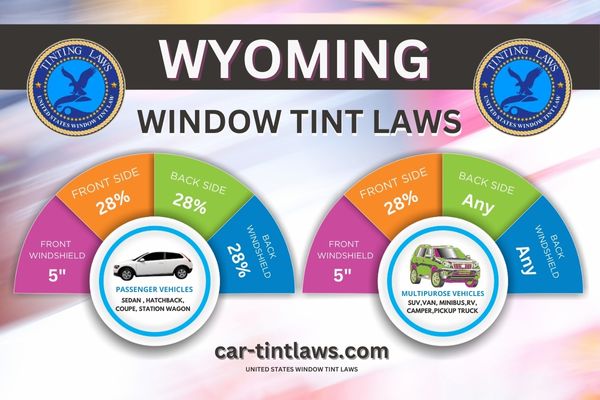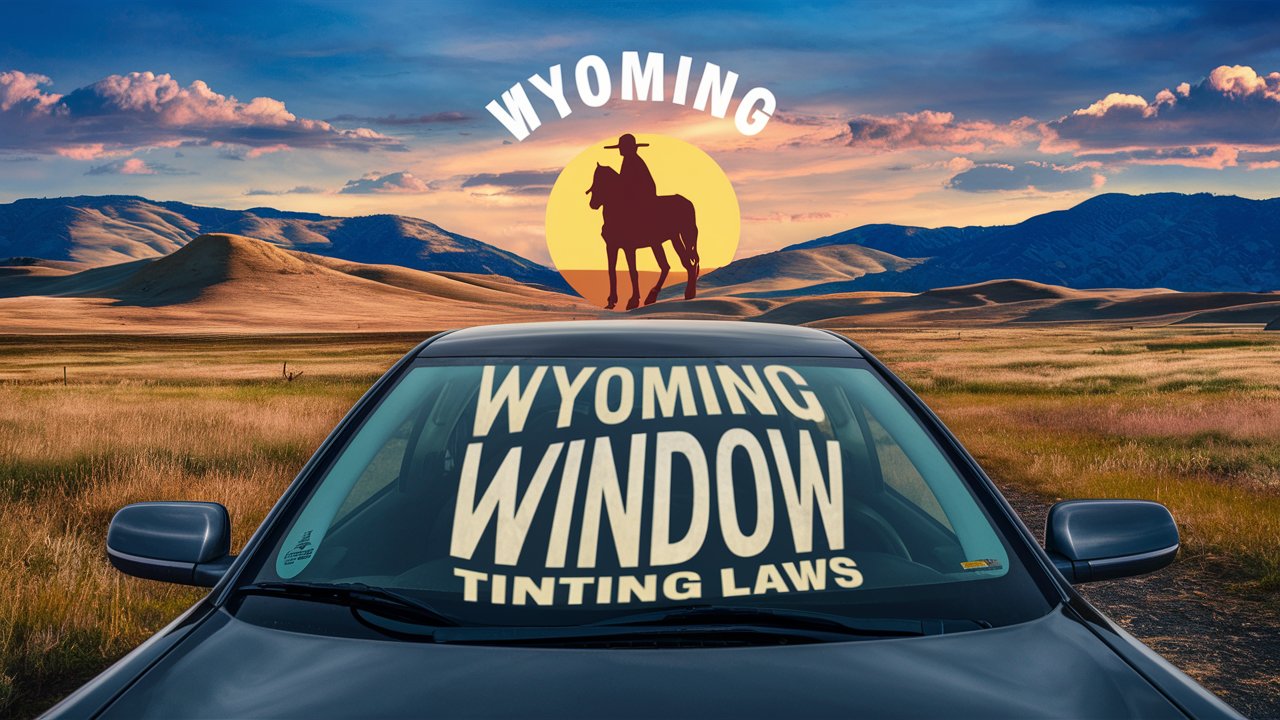Did you know that Wyoming has specific window tinting laws that vary depending on the type of vehicle you drive?
For instance, sedans require more than 28% of light to pass through all side and rear windows, whereas SUVs and vans have different standards.
This isn’t just about aesthetics; it’s also about balancing visibility and safety. You’ll find that Wyoming’s regulations even allow for medical exemptions under certain conditions.
Curious about how these rules might affect your vehicle or if you qualify for an exemption? There’s more to uncover about these state-specific guidelines.
Window Tint Darkness in Wyoming
When considering window tint darkness in Wyoming, it’s important to know the specific regulations for different vehicle types.
For sedans, the front, back, and rear windows must allow more than 28% light transmission, while reflective tint is limited to 20%.
Similarly, SUVs and vans must also adhere to these standards, ensuring that visibility and safety are maintained on the road.
Tint darkness for sedans:
- Windshield: Non-reflective tint is allowed on the top 5 inches of the windshield.
- Front Side windows: Must allow more than 28% of light in.
- Back Side windows: Must allow more than 28% of light in.
- Rear Window: Must allow more than 28% of light in.
Tint darkness for SUV and Vans:
- Windshield: Non-reflective tint is allowed on the top 5 inches of the windshield.
- Front Side windows: Must allow more than 28% of light in.
- Back Side windows: Any shade can be used.
- Rear window: Any shade can be used.
Window Tint Reflection in Wyoming
When considering window tint reflection in Wyoming, you need to know that the state limits reflectivity to 20% for both front and back side windows.
This regulation applies equally to sedans, SUVs, and vans, ensuring a consistent standard across all vehicle types. Exceeding this limit can not only impair visibility but also result in fines and penalties.
Tint reflection for sedans:
- Front Side windows: Tint reflection should not exceed 20%.
- Back Side windows: Tint reflection should not exceed 20%.
Tint reflection for SUV and vans:
- Front Side windows: Must not be more than 20% reflective.
- Back Side windows: Must not be more than 20% reflective.
Other Wyoming window tint rules and regulations
- Side Mirrors: No restrictions.
- Restricted Colors: In Wyoming all tint colors are permitted.
- Certificates: Manufacturers of film need to certify the film they sell in the state. Ask your dealer if they are using certified film.
- Stickers: The sticker/label of compliance to identify legal tinting is required between the film & glass on each tinted window.
- Medical Exceptions: Wyoming permits medical exemptions for special tint. For more details about the specific terms of the exemption, consult WY state law.
- Penalties: Violating tint laws in Wyoming can result in a ticket. It’s important to be aware of the regulations to avoid fines.

Medical Exemptions for Window Tint Rules in Wyoming
Individuals in Wyoming with certain medical conditions can qualify for darker window tints on their vehicles through a physician’s statement.
These medical exemptions are specifically designed to help those who suffer from light sensitivity or other conditions that make standard window tint rules insufficient.
To qualify, you’ll need a physician’s statement that details your medical necessity for darker tints on your vehicle windows.
While standard vehicles in Wyoming must adhere to Visible Light Transmission (VLT) limits, medical exemptions provide flexibility for those with specific health needs.
This system is carefully crafted to balance personal health concerns with road safety regulations. It ensures that while you can have darker tints to protect your health, you’re still complying with overall safety guidelines.
The state of Wyoming understands the significance of accommodating medical conditions while maintaining a safe driving environment for everyone.
This balance is essential for promoting both individual well-being and public safety.
If you believe you qualify for a medical exemption, consult your physician and make sure you have the appropriate documentation before proceeding with any tint modifications to your vehicle windows.
Wyoming Window Tint Ticket Cost
In Wyoming, getting caught with illegal window tint will cost you a minimum of $110. Wyoming window tint laws are strict, and drivers must make sure their vehicle’s tint complies with state regulations.
If you’re found in violation of these window tinting laws, you could receive multiple citations, each adding to your total fines and citations.
Law enforcement officers have the discretion to issue warnings for illegal tint, but you shouldn’t count on getting a pass.
It’s advisable to promptly remove any illegal tint to avoid further penalties. By choosing legal window tint, you can steer clear of these fines and citations altogether.
Wyoming tinting laws are clear about what constitutes legal window tint. Familiarizing yourself with these Wyoming window tint laws will help you guarantee your vehicle remains compliant.
The fines for an illegal tint ticket can add up quickly, and repeated offenses could lead to even steeper penalties. As such, understanding and adhering to Wyoming law is essential to avoid unnecessary costs.
Wyoming Population and Geography
Wyoming, with its population of about 580,000 people, is the least populous state in the U.S., spread across a vast area of over 97,800 square miles.
The state features a mix of urban areas like Cheyenne and Casper, and extensive rural regions with some of the lowest population densities in the country.
This demographic distribution, combined with Wyoming’s diverse geography of mountains, plains, and deserts, notably impacts the climate and, consequently, the considerations for window tinting laws.
Demographic Distribution Overview
With a population of around 578,000 people spread over 97,813 square miles, Wyoming boasts one of the lowest population densities in the U.S., averaging just 6 people per square mile.
This sparse demographic distribution significantly impacts daily life, including aspects like window tinting laws.
Wyoming’s largest city, Cheyenne, along with Casper and Laramie, are where you’ll find the highest concentrations of people.
However, much of the population resides in rural areas, contributing to the state’s low overall density.
The demographic makeup of Wyoming is primarily Caucasian, but you’ll also encounter noteworthy Native American and Hispanic communities.
These diverse groups add to the rich cultural fabric of the state. Understanding the demographic distribution is essential for grasping how laws, including those related to window tinting, are applied and enforced across different regions.
Rural areas may have different practical considerations compared to more populated cities like Cheyenne, Casper, and Laramie.
The low population density means that residents often rely heavily on their vehicles, making window tinting a pertinent topic for many.
Knowing who lives where and how they use their vehicles helps in understanding the broader implications of Wyoming’s window tinting laws.
Urban Vs Rural Areas
The contrast between Wyoming’s urban and rural areas shapes not only the daily experiences of its residents but also the enforcement and relevance of window tinting laws.
Urban areas like Cheyenne, Casper, and Laramie boast higher population densities and more developed infrastructure.
These urban centers offer greater access to services, healthcare, and amenities, which can influence the practicality and necessity of window tint regulations.
In rural areas, where over 60% of Wyoming’s population resides, the landscape is vastly different. The immense land area classified as rural means less development and potentially limited access to essential services.
The sparse population density and fewer amenities might make the enforcement of window tinting laws less strict compared to urban areas.
In these regions, the daily commute and lifestyle demands may differ significantly from those in urban centers, affecting how residents perceive and adhere to tinting regulations.
Urban development in Wyoming is concentrated in small pockets, surrounded by expansive rural lands.
This division underscores the state’s unique blend of developed and undeveloped areas, each with distinct needs and challenges.
Understanding this dynamic is vital to grasping the broader implications of Wyoming’s window tinting laws.
Geographic Climate Impact
Given the vast and varied landscape of Wyoming, the state’s geographic and climatic conditions greatly influence residents’ window tinting needs.
Wyoming’s diverse geography, spanning 97,813 square miles, includes mountains, plains, and valleys, each affecting sunlight exposure differently.
With a population of around 579,000 people, many residents live in areas where the high elevation and clear skies contribute to intense sunlight exposure.
This makes window tinting a practical choice for protection against the sun’s harmful rays.
In addition to sun protection, window tinting in Wyoming offers valuable insulation benefits. The state experiences both hot summers and cold winters, requiring residents to manage their indoor climates effectively.
Tinted windows help by reducing heat during summer months and retaining warmth during the colder seasons, enhancing overall comfort and energy efficiency.
Furthermore, privacy is another significant factor for many Wyoming residents. Given the state’s expansive and sometimes isolated locations, window tinting provides an added layer of privacy for homes and vehicles.
Whether you’re traversing mountain roads or open plains, the right window tinting can improve both comfort and safety by reducing glare and enhancing visibility under varying light conditions.
References
Frequently Asked Questions
What Is the Darkest Legal Tint in Wyoming?
The darkest legal tint in Wyoming is 28% light transmission for front, back side, and rear windows. This regulation balances safety concerns, UV protection, heat reduction, and visibility. Stay updated on changing regulations to avoid fines.
What Are the Tint Laws in Wyoming 2024?
If you’re in a jam about Wyoming’s 2024 tint laws, here’s the lowdown: non-reflective tint above the AS-1 line, 28% VLT for side windows, with exemptions, tint inspections, and maintenance required. Beware of tint tickets!
What State Has the Darkest Tint Law?
When considering tint darkness regulations, you’ll find Michigan has the darkest legal limits. State comparisons show their tint laws allow more opacity. Enforcement and penalties vary, but privacy, visibility, UV protection, and proper installation techniques are essential.
What Is the Darkest Legal Tint Percentage?
Imagine a protective shield for your car. The darkest legal tint percentage is essential for balancing vehicle safety, UV protection, privacy concerns, and heat reduction. Tinting regulations guarantee benefits while tint enforcement and inspections maintain compliance.
Conclusion
Wyoming’s window tinting laws serve as a guiding light, ensuring a balance between personal comfort and road safety.
By adhering to specific percentages for light transmission and reflection, drivers can stay within legal bounds and avoid penalties.
Additionally, medical exemptions provide necessary flexibility for those with health conditions.
Understanding these regulations helps maintain a clear view on the road, symbolizing the clarity and safety that these laws aim to uphold for everyone.
